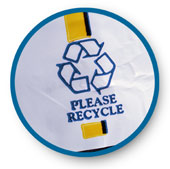Resources for Recycling in Specific Sectors

Local governments can work with organizations in various sectors to reduce waste and increase recycling.
- Event Recycling
- Business Recycling
- School Recycling
- C&D Materials
- Organic Materials
- Industrial Non-Hazardous Waste
- Innovative Approaches for Increasing Participation in Residential Programs
Event Recycling
EPA Recycle On the Go
The EPA Recycle on the Go initiative provides resources on recycling at events and in public spaces, including step-by-step information on how to set up a recycling program.
NERC Special Event Guide
The Northeast Recycling Council (NERC) developed a guide for special event organizers and individuals responsible for waste management at special events in rural communities. See:
Best Management Practices Guidebook for Special Event-Generated Waste in Rural Communities (PDF). (38 pp, 1.4MB, About PDF) ![]()
Business Recycling
EPA WasteWise Program
The WasteWise program can provide technical assistance to businesses in your community to help them prevent waste, recycle, and buy recycled. The WasteWise Web site offers numerous resources on waste reduction at businesses and other types of organizations.
Oregon Packaging Reduction Web Site
Oregon Department of Environmental Quality ![]() developed a Web site to help businesses prevent waste associated with packaging. The site includes descriptions of different methods for reducing packaging waste, checklists for evaluating packaging, and numerous other resources.
developed a Web site to help businesses prevent waste associated with packaging. The site includes descriptions of different methods for reducing packaging waste, checklists for evaluating packaging, and numerous other resources.
School Recycling
Numerous school recycling resources are available for school administrators, teachers, and students that provide information on waste reduction; present ideas for classroom, after-school, and extra-credit activities; and provide lesson plans and school projects.
C&D Materials
EPA estimates that 136 million tons of building-related C&D debris was generated in the United States in 1996. Reducing and recycling construction and demolition materials conserves landfill space, reduces the environmental impact of producing new materials, creates jobs, and can reduce overall building project expenses through avoided purchase/disposal costs.
EPA’s C&D Web site provides:
- An overview of the C&D debris waste stream and disposal practices.
- A wide range of C&D debris reduction techniques by methodology and by material.
- C&D reduction success stories.
- Tips on reducing and preventing C&D debris when planning a construction/remodeling project.
- Information on regional and state programs.
- Additional publications, case studies, and factsheets.
Organic Materials
EPA’s Greenscapes program provides cost-efficient and environmentally-friendly solutions for landscaping. Designed to help preserve natural resources and prevent waste and pollution, GreenScapes encourages companies, government agencies, other entities, and homeowners to make more holistic decisions regarding waste generation and disposal and the associated impacts on land, water, air, and energy use.
- Greenscapes also developed several brochures to help both consumers and large-scale landscapers convert their landscapes to GreenScapes.
Industrial Non-Hazardous Waste
Reusing or recycling industrial, non-hazardous materials not only keeps them out of landfills, but also reduces greenhouse gas emissions and saves energy. EPA promotes the efficient management of industrial wastes through the beneficial use of secondary materials—industrial, non-hazardous wastes that can be reused and recycled.
Learn more about the beneficial use of secondary materials through EPA’s Web site on reusing and recycling industrial materials.
Innovative Approaches for Increasing Participation in Residential Programs
Social Marketing
Social marketing is the use of commercial marketing concepts and techniques to target populations to achieve the goal of positive social change. Communities around the country are using social marketing strategies to increase recycling rates.
-
The North Carolina Division of Pollution Prevention and Environmental Assistance developed the RE3 Campaign
 focused on increasing participation through social marketing. The Web site includes case studies of approaches tested by North Carolina communities.
focused on increasing participation through social marketing. The Web site includes case studies of approaches tested by North Carolina communities. -
The Ohio Department of Natural Resources developed a guidebook, Social Marketing for Recycling in Ohio (PDF), (89 pp, 808K, About PDF) and conducted local community workshops.
Pay-As-You-Throw
Pay-As-You-Throw (PAYT) Programs (also known as unit pricing or variable-rate pricing) charge residents for the collection of municipal solid waste—based on the amount they throw away. This creates a direct economic incentive to recycle more and to generate less waste. PAYT breaks with tradition by treating trash services just like electricity, gas, and other utilities.
Sampling of successes with PAYT programs:
Neighborhood Programs
- The City of Raleigh, North Carolina recycling block leaders act as a liaison between residents and the local recycling office. This group works to increase curbside recycling participation by establishing a norm for recycling in their neighborhoods. The City of Raleigh recycling block leaders distribute informational brochures and flyers, answer questions and place reminder signs in their yards the day before recycling pick-ups. For more information on the Raleigh block leaders initiative, please contact Linda Leighton, with the City of Raleigh at (919) 831-6494.
Banning Disposal of Recyclable Materials
- The City of Seattle prohibits the disposal of certain recyclables—such as paper, cardboard, glass, plastic, and aluminum cans—from residential, commercial, and self-haul garbage. City of Seattle Ordinance #121372
 aims to save residents and businesses up to $2 million per year, keep future garbage costs low, and reverse a decline in the city’s recycling rate.
aims to save residents and businesses up to $2 million per year, keep future garbage costs low, and reverse a decline in the city’s recycling rate.
![[logo] US EPA](../gif/logo_epaseal.gif)